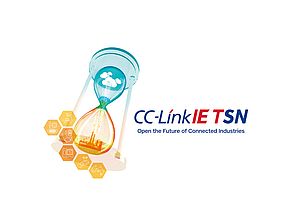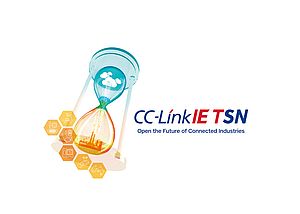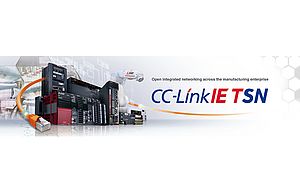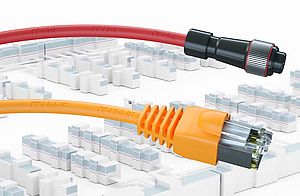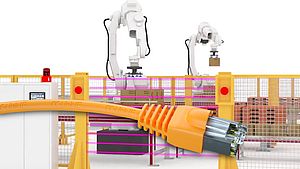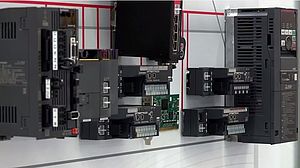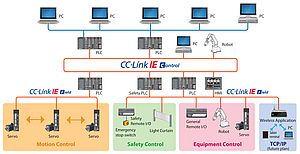Following the CLPA supplement published in the last April issue, as well as a series of articles related to examples of TSN implementation from companies such as NXP Semiconductors, Intel, HMS, Renesas or Moxa, The CC-Link partner organisation CLPA teamed up again with IEN Europe in an 8-page supplement to highlight the options for how TSN’s benefits to manufacturing can be achieved. This supplement is an invitation for you to discover the whole CLPA whitepaper.
When it comes to time-sensitive networking, exciting times are literally ahead of us. Connected Industries are necessary to support the aims of Industry 4.0. They rely on data and the insights that can be gained from it. In such facilities, it is fundamental to set up seamless interconnectivity from the smallest sensor on the factory floor up to enterprise-level systems and beyond. TSN, supported by gigabit bandwidth, delivers this by enabling convergence, the ability for multiple types of network traffic to share a common network architecture and thus avoid the data ‘silos’ of the past.
Industry 4.0-oriented digital technologies have the potential to transform manufacturing, but they also generate a vast amount of data that can become overwhelming if not managed properly. To succeed with value-adding digital transformation strategies, a converged, high bandwidth network infrastructure is crucial. Convergence refers to the concept of allowing everything to share the same network architecture, avoiding the complexity and cost of multiple networks. The ideal system should enable high-speed, real-time deterministic communications between disparate devices and systems, allowing data to be shared across the entire enterprise, regardless of its source or destination. This will provide the process transparency required for fully optimized operations by allowing data to flow from its source to where it can be processed to obtain actionable insights and then fed back into the process. Having real-time control and coordination of multiple different shop floor or operational technology (OT) systems is also critical.
The white paper explores Time Sensitive Networking (TSN) as a network technology that can address these challenges. TSN can deliver four specific benefits to a range of industries: Simplifying network architectures and machine designs, reducing costs, shortening project timelines, and increasing uptime. By employing convergence, systems no longer need multiple network types to handle all process traffic.
Delivering greater process transparency and optimized operations. As a consequence of converged network architectures, having data flow to where it is needed is simplified.
Increasing productivity, as optimized processes will run in the most productive way. Better integration of OT and information technology (IT) systems, as a converged stream of data can be shared from the factory floor to supervisory systems more easily, simplifying the process of getting the data to where it can be analyzed and contributing to process optimization.
In summary, Industry 4.0-oriented digital technologies generate a large amount of data that can become overwhelming if not managed properly. A converged, high bandwidth network infrastructure is crucial to managing this data and achieving fully optimized operations. Time Sensitive Networking (TSN) can provide the necessary network technology to simplify network architectures, increase process transparency, productivity, and better integrate OT and IT systems.
The challenge of Industry 4.0 and the promise of convergence
The industry 4.0 paradigm is transforming manufacturing by using data-driven, automated technologies that increase digitalisation and interconnectivity within companies and their supply chains on every single aspect including R&D. By using the Industrial Internet of Things (IIoT), these technologies increase the digitalisation and interconnectivity within companies as well as with their suppliers and customers in their broader value chains. In this way, it is possible to develop smart, connected industries that benefit from fully optimised processes. At the core of any digital journey is the ability of companies to navigate massive and ever increasing volumes of data to gain unique, actionable insights that support real-time decision making. However, a key challenge for manufacturers is implementing effective data gathering and integration solutions to support visibility, analytics, and optimisation. Additionally, traditional industrial Ethernet has limitations in supporting the higher levels of performance, connectivity, and cybersecurity required by Industry 4.0 applications.
Delivering convergence across the enterprise
Typically, companies have been relying on multiple networks in their operations. The shop floor, or OT level, features production lines or processes where multiple networks are employed. Along with these may be non-real-time traffic, such as video frames from inspection systems, barcodes, printed information, quality and maintenance data. These have often required separate networks, leading to complex architectures that could be costly and time consuming to install, operate and maintain. As a result, there is often a limited ability to provide the level of transparency required to control processes in an optimum way. When it comes to sharing this data with higher level IT systems to make it available across the enterprise, managing the multiple streams and combining them has also been difficult.
To address these challenges, companies can adopt a converged approach that allows all devices and systems to talk on the same network architecture, avoiding the complexity and cost of multiple networks. Convergence enables the application of IT intelligence to OT systems, creating an in-depth understanding of machines, processes, and plants to optimise processes, drive up efficiencies, and maximise productivity. However, convergence presents challenges and concerns that need to be overcome, such as traffic conflicts, lack of bandwidth, and prioritisation.
Before companies can progress on their Industry 4.0 digitalisation journey to full process optimisation, they need a network infrastructure that addresses the following challenges: convergence of multiple types of real-time process-related traffic, convergence of real-time process traffic with non-real-time traffic, convergence of different non-interoperable industrial Ethernet protocols, convergence of OT and IT systems, and ensuring all traffic is secure and protected from unauthorised access.
Time Sensitive Networking (TSN) can provide the right solution as it is an innovative, complementary technology that addresses the limitations of conventional industrial Ethernet. TSN enables convergence of multiple types of traffic while ensuring determinism, low latency, and real-time delivery. Additionally, TSN provides end-to-end security and protection from unauthorised access, making it a suitable technology for the Industry 4.0 era.
Automotive
In its Chapter 3, the whitepaper discusses the automotive industry's challenges in implementing innovative manufacturing systems to address the increased demand for vehicles with more features and options while increasing operational sustainability. This industry is under more and more pressure to implement innovative manufacturing systems that can address all these needs while increasing operational sustainability overall. Two main challenges stand out, including the vast amount of data that must be handled to manage different processes in an assembly plant and the complexity of the equipment and systems installed in a typical plant through their huge variety and their need to interact with each other whether at their own level or at higher levels. Time-Sensitive Networking (TSN) can help address these challenges by supporting gigabit bandwidth and the ability to converge multiple networks into a single architecture. This convergence can help to simplify complex systems found in plants, reduce system costs, expedite production schedules, and improve line efficiency. Convergence also offers a way to address the "islands" of automation in plants due to evolving installations, providing greater visibility and improved operation of processes. Keeping systems secure against unauthorized access is also a key concern, and TSN provides a simplified foundation for monitoring network traffic to prevent harm. TSN is already being implemented in various automotive applications worldwide. This is further evidence that its benefits have been understood by the industry and that these are now being exploited in a variety of systems and processes at different end users.
Food & beverage
The food and beverage industry and its needs are also on the focus, including ensuring optimum process conditions to obtain delicious foods and beverages, filling, packing, inspection, casing, and traceability of the finished product. This sector requires high production speed and volume to be profitable. Smart manufacturing and data are becoming key topics to help meet production goals, and having visibility of how close processes are to maximum efficiency is necessary to run processes at the highest productivity. Raw material costs are one of the main determinants of profitability, and process optimization can deliver significant benefits. TSN can address these challenges by providing a converged, gigabit communications architecture that can offer the potential for a high degree of process transparency, despite the use of many different systems across a plant. TSN also offers the opportunity for all systems to share information, ultimately providing the ability to see the big picture necessary to run a plant or line at maximum efficiency. Possible data islands caused by dissimilar systems may also be addressed by combining the traffic from different equipment onto the same network. Keeping the manufacturing process free of unauthorized interference is a key concern, and TSN provides a way to safeguard consumers and protect company reputations by making it simpler to monitor process data when converged onto a single architecture. Hence unauthorised actions can be detected more quickly and processes safeguarded in real-time. End users in the food and beverage sectors are already enjoying the benefits that TSN provides to their operations as they seek to address these challenges in the most effective, innovative ways.
Lithium battery
The lithium battery industry is expanding rapidly, driven by the demand for electric vehicles. TSN technology can help the industry address the challenges of maintaining high-quality manufacturing processes while increasing production capacity. TSN provides a converged network architecture with gigabit bandwidth, allowing high-performance motion traffic to share the same network as other types of machine control, safety, and vision systems. This reduces machine complexity and costs while increasing transparency and optimizing cell quality. This also leads to machines that can be deployed faster and can be maintained more easily, leading to higher productivity. Having the process traffic share a common network also allows it to be shared with supervisory systems more easily. This opens the door for increased process transparency and further development of machine learning facilities that can optimise the quality of the cells, increasing yields and avoiding the high costs of scrap product. TSN has already been implemented in cell manufacturing applications where these benefits are being actively exploited.
The process industry, which includes chemical plants, oil and gas, and other sectors, requires a distributed control system that monitors and manages processes spread over a large plant area. TSN's ability to use a unified gigabit network architecture can help optimize these systems, reducing engineering efforts and system complexity, and avoiding the need for separate networks for different protocols. Moreover, it can remove barriers to the necessary and seamless integration of all relevant plant systems (automation, instrumentation, networked IO, electrical distribution switchgear, safety instrumented systems, IIoT devices, edge gateways, etc.) for better plant operational and business performance. This can lower operational expenses, improve plant operations and product quality, and ultimately benefit customers and end-users throughout the value chain.
Water treatment
Water treatment is a critical activity that requires uninterrupted operation, low costs, and adherence to regulatory guidelines. The water industry is now turning to digitalisation in order to assure its future success and initiatives like “Water 4.0” are examples of this. Processes such as chemical dosing need to be further optimised. Vast supply networks benefit from intelligent data acquisition which in turn raises the issue of handling the huge amounts of data they generate. Cybersecurity is a key topic. TSN's deterministic, converged networks with gigabit bandwidth can help ensure water treatment processes are optimized in real-time, making corrective action quicker, increasing energy efficiency, and contributing to the security of supply. Integrating preventative maintenance systems can help prevent possible loss of supply and environmental non-compliance. TSN also offers communication upgrade possibilities for older infrastructure, which can help bring them in line with future initiatives.
Overall, TSN technology can help these industries improve their performance and optimize their processes while reducing costs, increasing transparency, and benefiting customers and end-users throughout the value chain.
John Browett, CLPA Europe, and Anis Zenadji
Additional Information
Virtual Exhibition Stand: http://cc-link-ve.eu/
CLPA Europe Homepage: https://eu.cc-link.org/en/
Connect with the CLPA on Social Media:
www.linkedin.com/company/cc-link-partner-association-europe
https://twitter.com/CC_LinkNews
https://twitter.com/CC_LinkNewsDE
https://twitter.com/CC_LinkNewsIT
https://www.xing.com/companies/cc-linkpartnerassociationeurope









